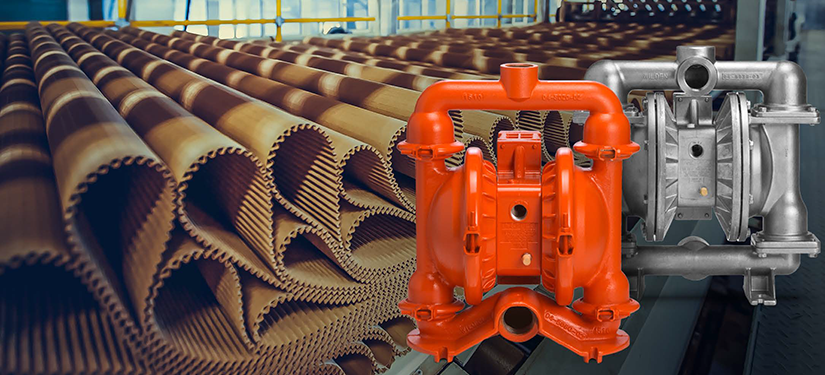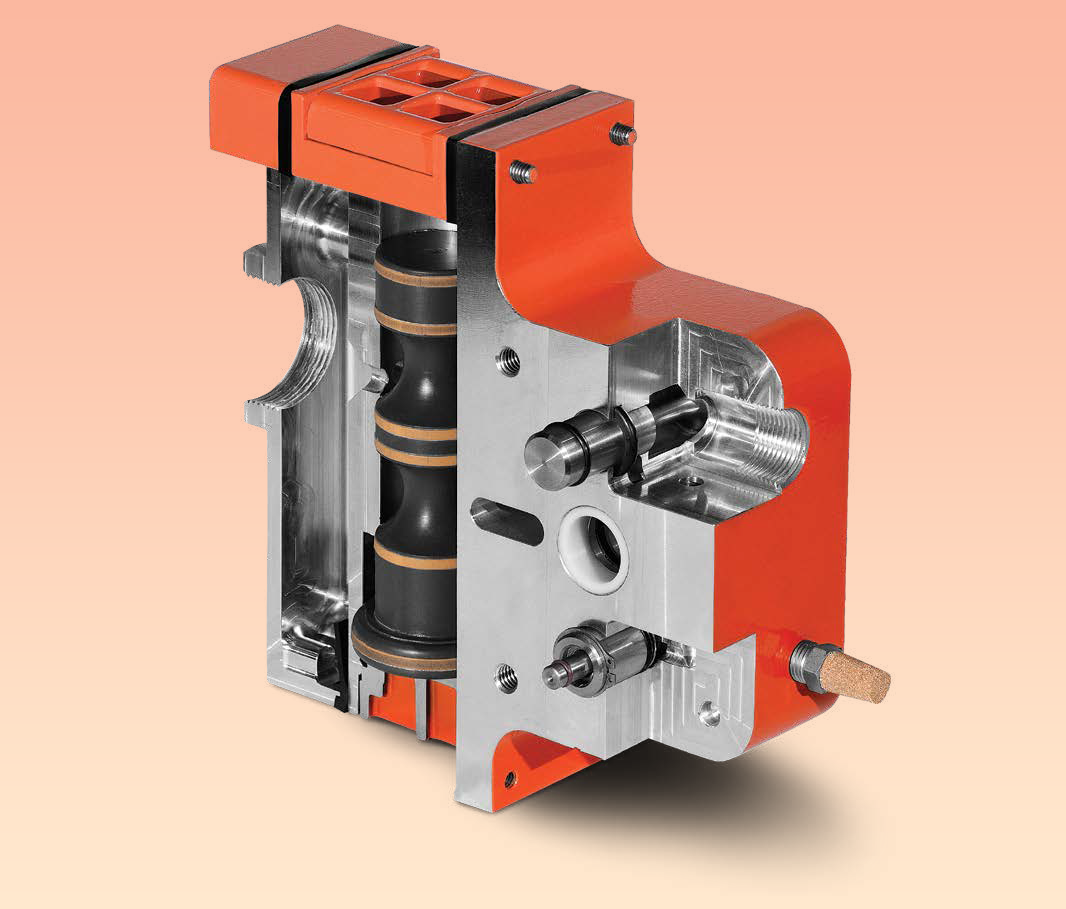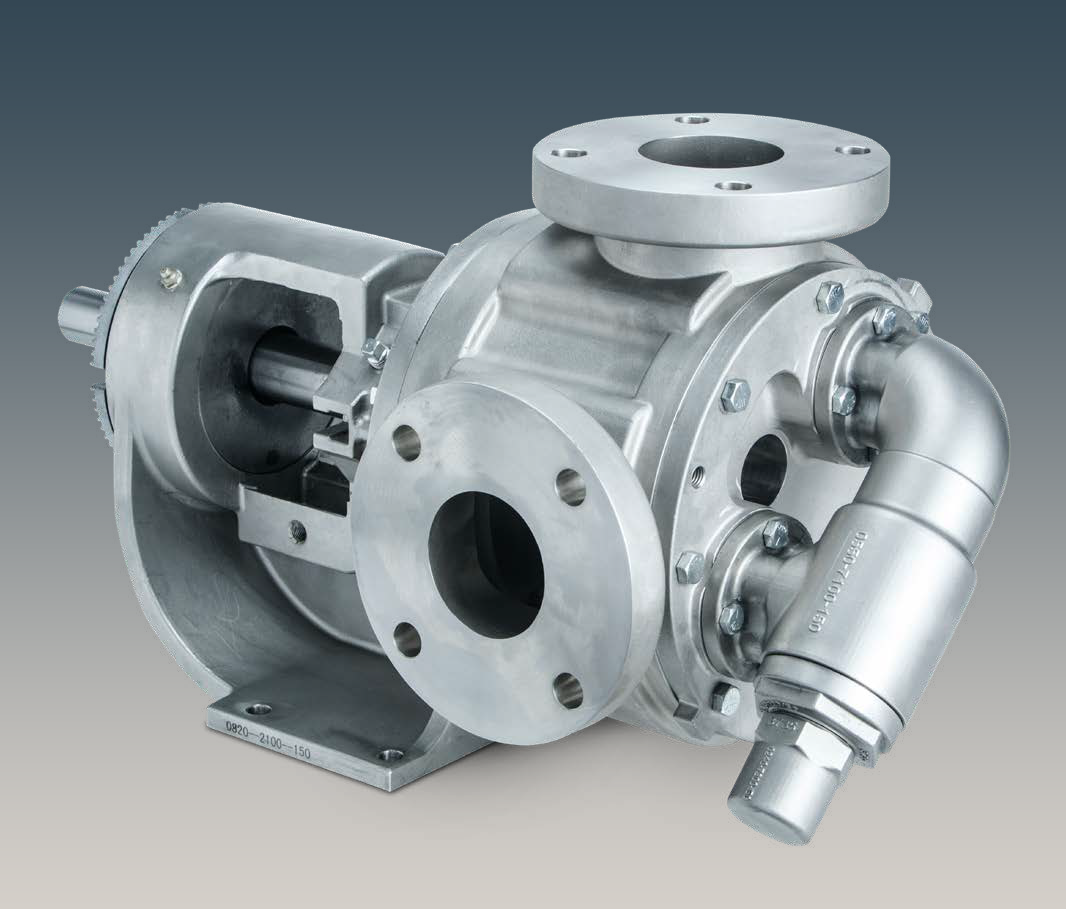
White Paper: Identifying the best pumps for glue transfer in corrugated box manufacturing
By Tom Zuckett and Jeff Peterson, PSG Dover Americas
Features AODD cornstarch glue corrugated boxes eCommerce internal gear PSG Dover pumps Wilden
Spurred by the growth of Internet-based eCommerce shopping and the corresponding demand for delivery packaging, corrugated cardboard boxes have become the world’s most widely used packaging material. That has also placed added importance on the manufacturing of corrugated cardboard boxes, especially the handling and transfer of the highly viscous and adhesive cornstarch glue that holds the boxes together.
Top: Because of their design and operational characteristics, Wilden air-operated double-diaphragm (AODD) pumps and Blackmer internal gear pumps have become go-to technologies for manufacturers who are looking to optimize their corrugated-box manufacturing operations.
Industrial pumps play a starring role in corrugated box manufacturing — transferring cornstarch glue that holds the cardboard sheets in a corrugated box together — and this white paper will illustrate how AODD and internal gear pumps can be the best option for use in this critical application.
The Challenge
Ironically, while the demand for corrugated boxes has exploded due to a series of technological advances in product ordering, the roots for the corrugated-box manufacturing process stretch all the way back to the less high-tech era of the 1880s. That’s when a Swedish chemist named Carl F. Dahl developed a method that took the raw wood from harvested tree trunks, such as fast-growing pines, and turned it into wood pulp consisting mainly of cellulose fibers, which are the foundational component in a piece of paper. He called his invention the “kraft” process, with the word “kraft” meaning “strength” in German, which acknowledges the strength of the paper that is produced through the kraft process.

All Wilden AODD pumps are portable, self-priming, dry-run capable and feature no mechanical seals, which makes them virtually leak-free and the perfect choice for handling cornstarch glue. They can also be outfitted with the Chem-Fuse Integral Piston Diaphragm (IPD), which offers improved service life and 100% increased flow rates when compared to PTFE-laminate diaphragm designs.
In the kraft process, raw wood chips are treated with a mixture of hot water, sodium sulfide (also known as “white liquor”) and sodium hydroxide to break down the cellulose (the main structural component in the cell wall of green plants), hemicellulose and lignin (organic polymers that support plant tissues) in the wood. This treatment turns the wood chips into soft and pliable wood pulp, which is then ready to be manufactured into paper.
Once the kraft paper is produced, it is sent to the corrugating plant where it will be turned into a finished corrugated cardboard box. Only a few materials and stages of production are needed to complete the manufacturing process. As mentioned, one of the most critical is the application of the glue to the various sheets of cardboard that are used to construct the box.
Most larger corrugating plants feature a facility that is unique to box manufacturing: the “starch kitchen.” It is in the starch kitchen that corrugated-box glue is created in a process that involves the mixing of cornstarch, some chemicals and boiling water, resulting in the formation of a thick, pasty liquid. The benefits of using starch-based adhesives in the construction of corrugated boxes are many: good adhesion to wood-based papers, ready availability, easy to apply, inexpensive, resistant to heat, slow curing, non-toxic and insoluble when used with fats and oils.
Because a large amount of cornstarch is needed at a corrugating plant, it is typically shipped in the form of a dry powder to the plant via railcar. At the plant, it is stored in silos before being transferred to the mixing vessels where the glue is produced. It is at the conclusion of the cornstarch-glue production process that industrial pumps enter the picture.

Outfitting a Wilden AODD pump with the Pro-Flo SHIFT Air Distribution System (ADS) will reduce air consumption by up to 60% while creating flow rates that can be 34% greater than other AODD-pump models.
Specifically, pumps are used to transfer the finished glue into the corrugating machine, from which it will be spread over the layers of corrugated medium that will be pressed together to form the completed corrugated cardboard sheet and, eventually, the cardboard shipping or storage box.
The challenge in this process that the pump must overcome is found in the fact that cornstarch glue can be difficult to pump because of its adhesive nature, along with its high viscosity. In addition to being sticky and thick, any liquid cornstarch glue that remains within the pump’s internals when it is not operating will harden. In this case, this hardened glue can cause premature wear that will adversely affect the ability of the pump’s mechanical seals/faces and bushings to operate properly. Even worse, when seals and bushings fail, the pump will be prone to leaks, which not only results in lost product, the cost of which can’t be recouped, but increases safety concerns as well as the need for costly cleanup procedures.
If a pump should have failed seals or bushings that can lead to leaks, the choice for the facility operator then comes down to whether the seals should simply be replaced or if the pump should be scrapped and exchanged for a new model. Replacing seals can be easy if spare inventory is on hand at the plant, but a pump that has additional performance-dampening damage may need to incur extensive labor and repair costs to get it back to its expected level of performance. In this case, the best option may be to purchase a new pump, though that can lead to longer periods of downtime, which compromises the manufacturer’s ability to meet strict production schedules. In both instances, there may also be a lack of skilled labor readily available to perform repairs or installation, which will lengthen downtime.
Therefore, it is imperative that the corrugating-plant operator identify and deploy a pumping technology that has been designed to confront and overcome the various challenges that are ever-present in the handling of cornstarch glue.
The Solution
As noted above, two of the best of these pumping technologies are AODD and internal gear. Specifically, two PSG product brands offer AODD and internal gear pumps that can be used in cornstarch-glue applications.

Blackmer G series Internal Gear Pumps feature a jacketed cast-iron body, ANSI flanges, bronze or carbon-graphite bushings, and carbon-graphite packing or Buna-N mechanical seal, all of which give them the capability to overcome the challenges of high viscosity and adhesiveness that are inherent in the handling of cornstarch glue.
First, Wilden, whose founder, Jim Wilden, invented the AODD-pumping principle more than 65 years ago, offers both clamped and bolted AODD pumps in 1-1/2, 2 and 3 in. outlet sizes. Wilden clamped metal AODD pumps feature Jim Wilden’s original design, which allows them to be easily installed and serviced with only a single tool. The Wilden bolted metal AODD pump features an enhanced flow-path design that can produce flow rates up to 34% higher than competitive models while offering maximum product containment. For both the clamped and bolted models (PS4, PS8 and PS15 for clamped; PS420/PS430, PS820/PS830 and PS1520/PS1530 for bolted) Wilden recommends a ductile-iron wetted path when handling cornstarch glue, though aluminum and stainless-steel models are also available.
Operationally, all the Wilden clamped and bolted pumps are portable, self-priming, dry-run capable and feature no mechanical seals, which reduces the chance that leaks will occur, resulting in superior product containment. They are also easy to operate, install and maintain.
The pumps are also able to be outfitted with Wilden’s Pro-Flo SHIFT Air-Distribution System (ADS). The innovative, yet simple, design of the Pro-Flo SHIFT ADS features an air-control spool that automatically optimizes and eliminates the overcharging of the air chamber with no reduction in flow rate. This reduction in air consumption helps Pro-Flo SHIFT pumps achieve up to a 60% reduction in air consumption while simultaneously producing up to 34% greater flow rates compared to other AODD-pump models.
In terms of diaphragms, Wilden suggests its Chem-Fuse Integral Piston Diaphragm (IPD). Chem-Fuse diaphragms are available in Wil-Flex (Santoprene) and can deliver 100% increased flow rates and suction-lift capabilities when compared to PTFE-laminate diaphragms. The IPD design eliminates a notorious leak point at the outer piston in traditional diaphragms. This elimination of outer-piston abrasion, and product trap areas, results in longer flex life and increased product containment.
In the realm of internal gear pumps, PSG offers the G series Internal Gear Pump from Blackmer.
The G series pumps are designed to deliver the durability, flexibility and efficiency needed when handling challenging liquids, such as cornstarch glue. Best designed for cornstarch-glue-handling applications are cast-iron G Series versions with ANSI flanges, bronze, or carbon-graphite bushings, with either carbon-graphite packing or a Buna-N mechanical seal. They are available in 2 and 3 in. outlet sizes (models G2-55 and G2-69) and can feature an optional internal-bypass relief valve.
Features of the G series pump include the ability to create and maintain turbulence-free laminar flow; a triple-lip seal that, in instances of the stuffing box becoming compromised, prevents product leakage; direct replacement-part interchangeability with a wide range of competitive pump models; and a universally designed seal chamber with an oversized heavy-duty bearing housing that can accommodate different sealing technologies. These pumps are standard in many “starch kitchens.” This is because the stuffing-box area on internal gear pumps allow the starch to settle out by displacing the liquid needed to lubricate the seal. The triple-lip seal also provides “dry-run” capabilities that help prevent early failure of the seal. Another design alternative is the “behind the rotor” design that positions the seal in fresher product, thus enhancing seal life.
Other optional accessories for G series pumps include an enlarged bearing housing at the rear end of the pump that provides easy drive-end access to the shaft seal and the ability for single-point end-clearance adjustment. Finally, the pump casing also revolves to allow for multiple inlet and outlet positions.
Conclusion
A corrugated box without cornstarch glue is just a pile of cardboard sheets, making the adhesive an indispensable piece of the corrugated-box manufacturing puzzle. However, the glue’s sticky properties, along with its high viscosity, make transferring it a challenge, which requires a specific type of pumping technology. As it turns out, PSG offers a pair of reliable, safe, and efficient solutions: Wilden AODD Pumps and Blackmer Internal Gear Pumps. Both technologies deliver the design and operational attributes that make them ideal for use with cornstarch glue in corrugated-box manufacturing, with all signs indicating that the market – and the resulting opportunities – will only continue to expand in the coming years.
Authors Tom Zuckett is the PSG AODD Business Development Manager, Americas (tom.zuckett@psgdover.com) and Jeff Peterson is the PSG Rotating Business Development Manager, Americas (jeff.peterson@psgdover.com).
Print this page